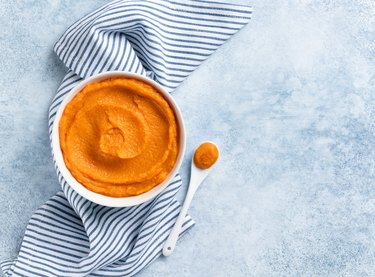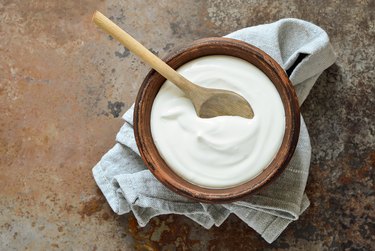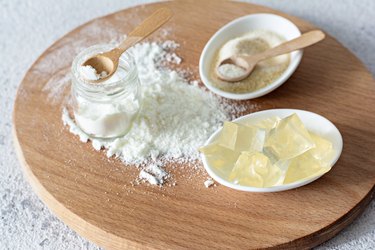
Replacing eggs in baked goods can feel intimidating. But if you have an egg allergy, want to master vegan baking or simply wish to stretch your egg supply for as long as possible, you'll need to learn how to incorporate egg substitutes. While it's tricky—and no one substitute is "best" for every purpose—there are ample options available. Some choices are obvious, such as commercial egg replacement products, while others might surprise you or strike you as downright weird. The bottom line? Whatever you're making, there's probably a substitute that will do the trick. To get you started, we've compiled a list of the best egg substitutions (along with their strengths and weaknesses) for your consideration. But first, a quick overview on egg substitutes...
Egg Substitution 101
Video of the Day
Eggs can be tricky to replace because they serve so many purposes cooking and baking. Egg whites add moisture and protein, which in turn adds structure to baked goods. When eggs (or egg whites alone) are whipped, they contribute to the leavening process. Egg yolks add fat and richness, as well as emulsifiers—ingredients that bond fats and liquids, which proverbially don't otherwise mix—such as lecithin. The net effect of yolks is to make baked goods soft and moist with a tender crumb.
Video of the Day

Finding one substitute to achieve all these benefits proves challenging. Some substitutions—starches, gums and ground seeds, for example—create gels, which provide structure that would otherwise come from egg whites' proteins. Others add protein and moisture in their own right, such as plain yogurt or silken tofu. Thick fruit or vegetable purées give a richness and moisture that might otherwise have come from egg yolks.
Each substitute has its own virtues. With a bit of experimentation and attention to a few crucial tips, you'll learn which egg alternatives work best in each of your favorite recipes. Replacements will almost invariably make baked goods denser and the crumb a bit firmer than with eggs. It's almost never a bad idea to add an extra dash of baking powder (or other appropriate leavening agent) to counteract this tendency.
Egg Substitution Quick Tips
- Start with one egg: The more your recipe relies on eggs, the more difficult it will be to replace them entirely. A recipe that calls for a single egg, for example, will almost always work better than a recipe that calls for several. If you’re simply looking to cut your egg usage, start by substituting only one egg. If that works, try substituting a second one and see if the result is still acceptable.
- Don't underestimate soy lecithin: You can purchase soy lecithin in either liquid or granular form. It’s suitable for vegans and those with egg allergies, and—while not an egg substitute in its own right—it’s a great complement to most egg substitutes. Like the lecithin that occurs naturally in egg yolks, it will help make your baked goods soft, rich and tender.
- Consider savory recipes too: Egg substitutes are geared primarily toward baking as opposed to savory recipes, but there are a few use cases in savory cooking as well. Many egg substitutes work well to help bind casseroles that might otherwise call for an egg or two in the mixture, for example. Most aren’t suitable for simply cooking as eggs, though soft tofu can be “scrambled” in a skillet and served like an egg.
10 Egg Substitutes to Consider:
1. Commercial egg substitutes

Commercial egg substitutes, such as the ones from Ener-G and Bob's Red Mill, are built for versatility–and they're the easiest option if you're seeking an egg replacement for all or most of your baking. These commercial varieties are made from a combination of starches, leavenings and other gelling ingredients such as psyllium or plant-based cellulose. They won't replace eggs' flavor, but they'll work well in cookies, quick breads, yeast-raised breads and most other baked goods. Most important, they're well-tested and convenient, so you'll encounter lots of recipes calling for one or the other. Not all of these egg replacers are gluten-free, so be sure to read the ingredients carefully if you can't consume gluten.
2. Purified starches

When starches are mixed with water and heated, they quickly form bonds at the molecular level that trap moisture in a gel. That's why they work well for thickening gravies and sauces, and they're equally effective in baked goods. You can use any purified starches you have on hand, from rarer choices like arrowroot and potato starch to relatively common options like tapioca (the powder, not the pearls) and cornstarch. Whisk two tablespoons of your starch into three tablespoons of water to replace an egg. This relatively "all-purpose" substitution works for baked goods, puddings and casseroles—though, in baked goods, you'll want to add extra leavening (and lecithin, if you have it).
3. Psyllium

This substitution might initially leave you scratching your head because psyllium powder is commonly sold as a laxative, but we promise it's a safe and viable option. Psyllium powder is made from the seeds of a plantain variety: not the banana-like kind, but a close relative of the broad-leaf plantain that's commonly found as a lawn and garden weed. Psyllium is a form of soluble fiber, which means it creates gel when mixed with liquids. Furthermore, unlike starches, it will gel even without being heated (a bonus in recipes that have a short cooking or baking time).
Psyllium provides a good general-purpose substitution for use in most baking, though you'll get the best results in pancakes, cookies and quick breads (as opposed to light, "eggy" cakes). One potential downside is that psyllium absorbs a lot of moisture, so you might need to add extra liquid ingredients.
Tip
When you add liquids to eggless recipes, consider using a sparkling beverage like carbonated water, beer or a suitably-flavored soda to the batter (ginger ale in a spice cake, for example). The carbonation will help bring a little extra leavening power to the party, which keeps baked goods nice and light.
4. Aquafaba

This is another substitution that might strike you as strange, unless you're tapped into the vegan baking community. You know the thick liquid that's drained away from a can of chickpeas or other beans? That's aquafaba (literally, "bean water"). You can use liquid from any canned beans, though chickpeas are the most common choice because the aquafaba has a relatively neutral appearance and flavor. A key benefit of aquafaba is it can be whipped like egg whites and even used to make meringues. The foam won't be as durable as a foam made from whites, but aquafaba still works as a leavening agent in sponge cakes and other airy recipes.
There's a limit—for example, you won't be able to make an angel food cake, which is all egg whites, flour and sugar—but aquafaba opens the door to cakes and recipes you couldn't attempt with most other egg substitutes, including light, fluffy waffles. You can even combine it with other egg substitutes, using psyllium or Ener-G in batter before folding in whipped aquafaba in lieu of beaten egg whites.
5. Silken tofu

Silken tofu sits at the opposite end of the spectrum from extra-firm varieties used for crispy tofu. It has a high moisture content and an almost custardy texture and, like every form of tofu, it's high in protein. This makes it a valid option for replacing eggs' contribution to a recipe's liquid ingredients (which add moisture) and protein (which add structure). You'll need 1/4 cup of tofu for each egg you're replacing. Just whip until very smooth and creamy, then stir in at the stage that you'd normally add eggs. Tofu does have a distinctively beany flavor and produces firm, dense baked goods, so it's best used for things like brownies, flourless chocolate cakes and banana bread or other strongly flavored quick breads.
6. Ground flaxseed or chia seed

Like psyllium, ground flaxseed and chia seed are filled with soluble fiber. You'll use them as egg substitutes in exactly the same way, mixing with water and waiting for them to gel before adding to your recipe. For every "flax egg," you'll need 3 Tbsp. ground flaxseed and 1 Tbsp. room temperature water (the same ratio applies for chia). Flaxseed needs to sit for about 15 minutes before a gel is properly formed, but chia seeds need only about five minutes—making them more convenient. These seeds won't give baked goods any leavening, so use them in cookies or brownies (where puffiness isn't especially desired) or put them in things like muffins or quick breads, adding extra leavening separately.
7. Applesauce and other purées

One go-to "cheat" for anyone baking sans eggs (or with reduced fat) is the use of purées. Depending on what you're baking, this often covers a lot of ground. You could use unsweetened applesauce, squash or pumpkin purée, mashed banana, avocado or even a can of crushed tomatoes. These aren't general-purpose substitutes, as a rule—most have distinctive flavor that needs to either complement or be hidden by the flavor of baked goods. Most also change the color of batter, which might affect your decision to use them.
A classic example of this substitution is using a standard 15-ounce can of pumpkin purée with one boxed cake mix, which—fortuitously—creates the perfect proportions for a moist, dense, richly flavored cake or cupcake batch. To use purées as a direct egg replacement, allow 1/4 cup purée for each egg you want to replace. Some purées are wetter than others (applesauce or crushed tomatoes, for example) and avocados are high in fat, so you might need to reduce those ingredients to compensate.
8. Plain yogurt

Plain yogurt, like silken tofu, brings both moisture and protein to baked goods and is incorporated in a similar way. You'll use 1/4 cup of yogurt for each egg the recipe calls for, stirred in at the same stage that you'd normally add eggs. Yogurt doesn't have tofu's distinctively beany flavor, but instead has a pleasant tang that complements things like chocolate cake, carrot cake or spice cake.
As a dairy product, of course, it's not vegan-friendly, but it makes a strong substitute otherwise. You can use buttermilk the same way, but you'll need to cut back on other liquids because buttermilk is thinner than yogurt. Both have the advantage of acidity, so you can get away with adding a pinch of baking soda for extra leavening. The soda will react with acidity in yogurt or buttermilk to give baked goods some lift while masking the distinctive baking soda taste.
Tip
You don’t necessarily have to restrict yourself to plain yogurt. Vanilla yogurt will work in most baked goods, and you can even use fruit-flavored yogurt in some recipes. Bear in mind that flavored yogurt is sweetened, so you’ll need to reduce other sweeteners slightly to compensate.
9. Gelatin

You've probably noticed by now that several of the best egg substitutes work by creating a gel, and you might have wondered, "Would gelatin work?" It does! It won't add richness or moisture, but it does lend structure to baked goods. Don't use too much, though, because it can result in an odd texture. For each large egg in a recipe, combine 1 Tbsp. unflavored gelatin powder with 3 Tbsp. water.
There are a couple of ways to do this. One is to let gelatin absorb 1 Tbsp. of room-temperature water, then add 2 Tbsp. of boiling water to dissolve it. Another is to add gelatin to all 3 Tbsp. of water, then melt in the microwave once fully hydrated. You can use the resulting gelatin "egg" in the same ways you'd use chia, flax or psyllium. Gelatin is problematic if you're baking for vegans (it's animal-derived), but there's an alternative called agar (seaweed-derived) that can be used exactly the same way as gelatin.
10. Mayonnaise

Yup, good ol' mayo. We're not talking about the "whipped dressing" mayo that's mostly vinegar and sugar, but actual mayonnaise. It's either one of the best substitutes or the worst, depending on your perspective. "Best" because it's made mostly with vegetable oil and eggs, so it's a very functional substitute and it's something you almost certainly have on hand. "Worst" because it's mostly made with oil and eggs, so it's not suitable for vegans or anyone with an egg allergy. If you're merely trying to stretch a dwindling carton of eggs or save yourself a trip to the store, though, it's ideal.
Simply add 3 Tbsp. of mayo for each whole egg the recipe calls for and you're good to go. Mayo will add a slight tang to recipes, but the end result will be largely indistinguishable from the eggy version. You might even find that cakes, cupcakes and quick breads have an extra-moist and tender crumb as a result. There are even a few vegan mayonnaise substitutes out there—and while they're as perfect as real mayonnaise in a cake, they'll work just as well as plain yogurt or another similar substitution.
Whether you're searching for substitutions in a pinch or making a concerted effort to replace eggs in recipes, we hope our primer offers insight into the many versatile (and often surprising!) options among us. Though there's no one singular, flawless stand-in for eggs, these selections make "egg-cellent" impersonators.